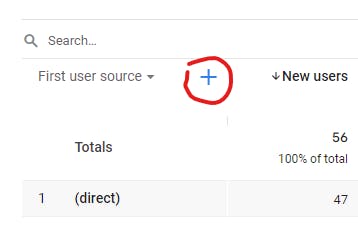Secondary Dimension in Google Analytics: Best Practices and Tips
Secondary Dimension in Google Analytics: Best Practices and Tips
Blog Article
Transform Your Analytics Approach With Secondary Measurement in Google Analytics
By integrating additional measurements right into data evaluation, a brand-new layer of insights arises, losing light on detailed user behaviors and interactions. The critical application of additional dimensions holds the crucial to opening a prize chest of invaluable details that can change just how companies interpret and act upon their information.
Recognizing Second Measurements in Google Analytics
Additional measurements in Google Analytics give added context to key data by allowing individuals to analyze metrics across a 2nd dimension, supplying deeper understandings into customer habits and communications on a web site. Secondary Dimension in Google Analytics. While main measurements supply essential information factors such as pageviews, bounce price, and session period, additional measurements offer a more comprehensive view by segmenting the primary data additionally. This division enables individuals to analyze metrics in mix with one more measurement, such as traffic sources, demographics, or customer behavior
Advantages of Utilizing Second Dimensions
Making use of second measurements in Google Analytics uses a critical advantage by improving the deepness of evaluation and providing a more thorough understanding of user interactions and habits on a website. By integrating second measurements, analysts can acquire valuable insights into the efficiency of certain sections or variables within their data. This allows a much more in-depth exam of individual habits beyond surface-level metrics, enabling a deeper exploration of the factors influencing customer involvement and conversions.

How to Execute Additional Dimensions
When integrating additional measurements in Google Analytics, one vital action is to select the relevant metrics and dimensions to enhance the evaluation procedure. To apply secondary dimensions successfully, start by accessing your Google Analytics account and browsing to the record you desire to enhance with additional information. Once in the report, locate the "Secondary Measurement" switch, typically located over the information table. Clicking this switch will open up a drop-down food selection listing various dimensions that can be contributed to your key measurement for deeper insights.
After choosing the ideal secondary dimension, such as 'Source/Medium' or 'Device Category,' Google Analytics will show the information in an extra in-depth format, enabling you to cross-analyze various aspects of customer behavior. Remember to trying out different mixes of secondary and key dimensions to reveal valuable patterns and fads that can educate your advertising methods. By implementing additional measurements attentively, you can acquire a more detailed understanding of your site or application efficiency and make data-driven decisions to enhance your digital existence.
Analyzing Information With Second Dimensions
Enhance your information evaluation in Google Analytics by including additional measurements to delve deeper right into user actions patterns and optimize your digital marketing methods effectively - hop over to these guys Secondary Dimension in Google Analytics. By adding second dimensions to your main data, you can obtain useful insights that can help you make informed decisions regarding your internet site or app performance
Analyzing information with additional measurements permits you to sector your main information better, supplying a more comprehensive view of user communications. Incorporating the main dimension of 'source/medium' with a secondary measurement like 'touchdown page' can disclose which specific web pages are driving web traffic from different resources. This information can be crucial in fine-tuning your content technique or maximizing your ad campaign to raise conversions.
In addition, utilizing Get More Info secondary dimensions allows you to identify connections between different metrics, helping you understand the effect of different elements on individual habits. Whether it's examining demographics together with individual interaction metrics or gadget classifications with conversion rates, secondary dimensions encourage you to reveal surprise fads and patterns that can lead your advertising and marketing initiatives.
Maximizing Performance With Additional Dimensions
To enhance the efficiency of data evaluation and decision-making in Google Analytics, including second measurements is crucial to enhancing performance metrics and acquiring deeper insights into customer actions patterns. By utilizing additional dimensions, experts can dig past surface-level information and reveal beneficial correlations that might or else go undetected. This optimization approach allows businesses to customize their advertising and marketing efforts better, determine locations for renovation in website functionality, and boost total customer experience.
Second dimensions provide a more extensive view of individual communications by giving added context to main information metrics. Matching the key dimension of 'touchdown page' with a secondary measurement like 'device group' can reveal whether particular gadgets are a lot more likely to drive involvement on particular landing web pages. This insight can educate receptive design improvements or targeted advertising approaches to improve performance.

Final Thought
In verdict, the assimilation of secondary measurements in Google Analytics gives companies with an effective tool to improve their analytics method. Secondary Dimension in Google Analytics. By diving deeper into customer behavior and interactions, marketing experts can uncover useful understandings that can drive performance optimization and boost the overall user experience. Leveraging second dimensions permits for a more detailed analysis of data, bring about more informed decision-making and customized advertising and marketing efforts
Additional measurements in Google Analytics offer added context to primary information by allowing customers to examine metrics across a 2nd dimension, using deeper understandings into customer habits and interactions on an internet site. While key dimensions give fundamental information points such as pageviews, bounce price, and session period, additional measurements supply an even more detailed view by segmenting the primary information better.One of discover this info here the vital advantages of utilizing additional dimensions is the ability to uncover correlations and patterns that might not be immediately apparent when analyzing information with main dimensions alone.When integrating secondary dimensions in Google Analytics, one important step is to pick the appropriate metrics and dimensions to enrich the analysis process. Pairing the primary measurement of 'touchdown web page' with an additional dimension like 'device category' can expose whether certain gadgets are more likely to drive involvement on specific landing web pages.
Report this page